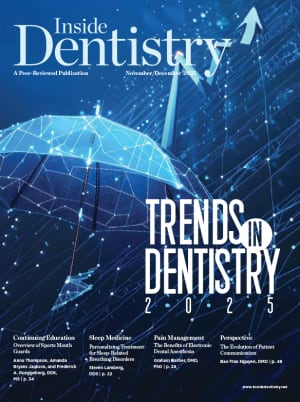Delivering the Benefits of Bioactivity With No Compromises
Shofu’s Beautifil® composites leverage Giomer Technology to reduce postoperative sensitivity and recurrent decay
After more than 2 decades in general dental practice, Ankur Gupta, DDS, remains dissatisfied with the imperfections inherent in traditional restorative dentistry that affect both patient outcomes and practitioner confidence. As a general dentist in the Cleveland, Ohio, area, Gupta regularly places direct composite restorations. Conventional composite materials have served the profession well; however, most of them remain largely inert after placement, so they provide structural restoration without contributing to the biologic healing process.
Traditional restorative approaches, while fundamentally sound, present inherent risks that can compromise patient satisfaction and treatment outcomes. For example, when treating asymptomatic carious lesions, which are often discovered during routine examinations, clinicians face the uncomfortable reality that successful cavity preparation and restoration may inadvertently create postoperative sensitivity that did not previously exist. Similarly, the traditional management of deep carious lesions in asymptomatic teeth often necessitates extensive treatment planning discussions regarding potential endodontic intervention, creating treatment complexity where none previously existed from the patient’s perspective. “Those two things stress me out,” Gupta says. “Doing a routine procedure and causing pain from sensitivity or needing to have a conversation with a patient to explain that I have to do something incredibly invasive that they never knew that they needed are scenarios that I’d prefer to avoid.”
The emergence of bioactive restorative materials, which represents a paradigm shift from inert restorative materials to those that actively participate in the oral environment’s biologic processes, is a significant advancement in addressing these longstanding concerns. Unlike traditional composites, bioactive materials incorporate components that continuously release beneficial ions into the surrounding tissues for the lifetime of the restoration, creating an environment that reduces bacterial colonization and promotes remineralization.
Using bioactive materials helps Gupta feel more confident in the restorative treatments he provides. His go-to is Shofu’s Beautifil® line of composites. Beautifil composites leverage Shofu’s Giomer Technology, a bioactive proprietary filler that actively releases six beneficial ions (ie, fluoride, strontium, sodium, aluminum, silicate, and borate) to help reduce the incidence of postoperative sensitivity and prevent secondary decay. “Basically, it looks and acts like traditional composite, but throughout its lifetime, it’s continuously releasing ions into the surrounding area,” Gupta says. “It’s actually going to aid in the rebuilding of hydroxyapatite in the dentin and enamel that surround that filling, which is excellent, especially considering the fact that most of the composite restorations that we place are going to develop some type of microleakage.”
Gupta explains how the continuous release of bioactive ions creates a more favorable environment around the restoration, particularly in areas closest to the pulp. “The acid-neutralizing properties of the strontium, combined with the remineralizing effects of the fluoride, help stabilize the pulp-dentin complex and reduce the likelihood of postoperative sensitivity,” he says. “Furthermore, the ion release creates a bacteriostatic environment at the restoration’s margins, which significantly reduces bacterial accumulation. This translates to decreased marginal staining—the brown lines commonly observed at composite margins after several years—and, more importantly, to a reduced risk of recurrent decay.”
Bioactive materials are neither new nor uncommon in the dental operatory. Glass ionomer materials have long provided bioactive properties. However, Gupta notes that they lack the physical characteristics to provide the strength required for many restorative applications. In addition, glass ionomers cannot match the handling characteristics or polishability of composite materials. Beautifil composites have been shown to demonstrate high compressive and flexural strength as well as exceptional resistance to wear. Moreover, they possess excellent handling characteristics and can be quickly and effortlessly polished to a high surface gloss.
“So, glass ionomers exist, and they have a place, but if you want bioactivity and to have the same packability, sculptability, and polishability of your regular composite, just use Shofu’s Beautifil composite,” Gupta says. “The Beautifil line includes a variety of options with different viscosities and different levels of packability to accommodate different clinical applications and preferences. You will find a composite in the line that’s going to work really well and be very similar to the composite that you already use, but it will also have bioactive benefits. Moreover, the Beautifil composites are incredibly cost-effective when compared with other brands.”
By selecting materials that actively contribute to the oral environment’s biologic processes, Gupta is comfortable that he can reduce postoperative sensitivity and enhance long-term restorative success. “Using Shofu’s Beautifil composites enables clinicians to provide more biologically compatible restorations without compromising on the physical properties and handling characteristics that they have come to expect from premium composite materials,” he says. “We’re all trying to do everything that we can for our patients, and this is something you can do to contribute to better outcomes without changing your protocols. You won’t be disappointed.”
Key Points
• Giomer Technology actively releases six beneficial ions to help reduce the development of postoperative sensitivity and prevent secondary decay.
• Available in a range of viscosities with different handling properties to suit all clinical scenarios.
• Demonstrates high compressive and flexural strength as well as exceptional resistance to wear.
• Quickly and effortlessly polishes to a high surface gloss.
Shofu | shofu.com | 800-827-4638
